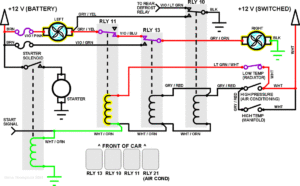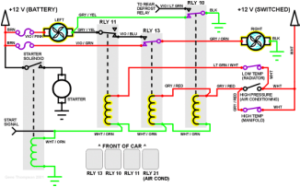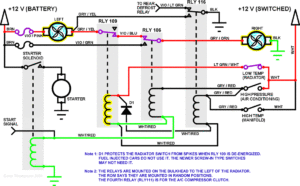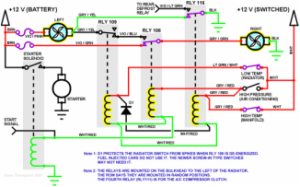
TR8 Cooling Fan System
This content originally published at our WWWedge site, on the Wedgelabs page(s) developed by Gene Thompson, and hosted at team.net. Gene Thompson retains all copyright for the material below, except where noted.
The radiator cooling fan system in many TR8s is comprised of two electric fans, two thermostatic switches, two fuses, three relays and a pressure switch if you have air conditioning. Additionally, the starter solenoid is involved in the circuit also.
The fans are supposed to work like this:
 Low speed - EFI: The thermostatic switch screwed into the left side of the radiator closes at 199°F (93°C). Relay 11 pulls in, placing the fan motors in series. That causes them to run at reduced speed, and draw one fourth the current demanded at full speed.
Low speed - EFI: The thermostatic switch screwed into the left side of the radiator closes at 199°F (93°C). Relay 11 pulls in, placing the fan motors in series. That causes them to run at reduced speed, and draw one fourth the current demanded at full speed.
 High speed - EFI: The thermostatic switch screwed into the intake manifold closes at 226°F (108°C). Relays 10 and 13 pull in, placing the fan motors in parallel for high speed operation. High speed will also be initiated if the pressure in the air conditioning system rises high enough. The high speed circuit will operate properly even if the low temp thermostatic switch or Relay 11 is broken.
High speed - EFI: The thermostatic switch screwed into the intake manifold closes at 226°F (108°C). Relays 10 and 13 pull in, placing the fan motors in parallel for high speed operation. High speed will also be initiated if the pressure in the air conditioning system rises high enough. The high speed circuit will operate properly even if the low temp thermostatic switch or Relay 11 is broken.
 Low speed - carburetors: The circuit works the same way as the one in the fuel injected cars. There is a diode added "backwards" across one of the relay coils. It prevents the high voltage spike that is generated when a coil is de-energized. The older clip-in style radiator switch may need it to be properly protected.
Low speed - carburetors: The circuit works the same way as the one in the fuel injected cars. There is a diode added "backwards" across one of the relay coils. It prevents the high voltage spike that is generated when a coil is de-energized. The older clip-in style radiator switch may need it to be properly protected.
 High speed - carburetors: The circuit works the same way as the one in the fuel injected cars. The thermostatic switch screwed into the intake manifold closes at 226°F (108°C). Relays 10 and 13 pull in, placing the fan motors in parallel for high speed operation. High speed will also be initiated if the pressure in the air conditioning system rises high enough. The high speed circuit will operate properly even if the low temp thermostatic switch or Relay 11 is broken.
High speed - carburetors: The circuit works the same way as the one in the fuel injected cars. The thermostatic switch screwed into the intake manifold closes at 226°F (108°C). Relays 10 and 13 pull in, placing the fan motors in parallel for high speed operation. High speed will also be initiated if the pressure in the air conditioning system rises high enough. The high speed circuit will operate properly even if the low temp thermostatic switch or Relay 11 is broken.
The fan system has some interesting quirks. Note that the coils of the three fan relays are are not grounded normally. Instead, the relay "grounds" are returned to the hot side of the starter solenoid coil. The starter solenoid winding has very low resistance - about a quarter of an ohm, to allow the high current flow necessary to provide the strong magnetic field required to move the starter pinion. Each fan relay has a coil resistance of around 80 ohms. So, the starter solenoid winding is just a fairly good ground wire as far as the fan relays are concerned. That changes when the engine is cranked. Battery voltage is applied to the starter solenoid and since the fan relay coils now have twelve volts at each end, they drop out, stopping the fans.
High speed operation will also turn off the coupe's rear window defroster to bolster the alternator's attempt to keep the battery charged.
If you have a continuing problem with blown fuses, don't assume that it's always caused by a short circuit somewhere. Over the last 40+ years the fan motor bearings have probably dried out and gotten dirty. The increased friction causes the motors to draw more current. In addition, the clips in the fuse block may have lost some of their spring tension. Passing high current through a poor connection can generate a lot of heat. The clips can get hot enough to blow the fuse element right at the end, where it's not visible. Not only can they blow the fuse, the clips can get hot enough to melt the fuse block itself. If your fans stop working, check the fuses with an ohmmeter, since they can be blown while still looking okay. Tighten the fuse clips by squeezing them together a bit before replacing the fuses.
If you have an engine overheating problem, do not short the thermostatic switch to make the fans run at high speed all the time - that will probably cause the fuses to blow when you least need trouble! I'm speaking from personal experience, here. If your fuses do blow, don't replace them with higher current ones. You'll wind up with a melted fuse block and maybe a car fire. Remember, British and American fuse ratings are different by about 2X. A 35 amp British fuse is about the same as a 17.5 amp American fuse. The British fuses are also a little shorter - forcing the wrong fuse into the holder may break it.
If you're looking for exact replacement fans, good luck! About the only other cars sold in America that used those exact fans were Fiat 124s and (I think) Stradas. Various vendors sell different cooling fan setups, but ultimately you may be best served by using a generic cooling fan and adapting it to the car. The Porsche Boxster fans will fit and work well, but they are rather costly.
Since the TR8 fans are set to turn on at a minimum temperature that is somewhat above the temperature where the radiator thermostat is fully open, the temperature gauge tends to bounce around if you are in slow traffic or stopped. New TR8 owners of air conditioned cars often think that something is broken, but this isn't the case. If it drives you nuts, you can fix it by making the fans come on at a lower temperature.
